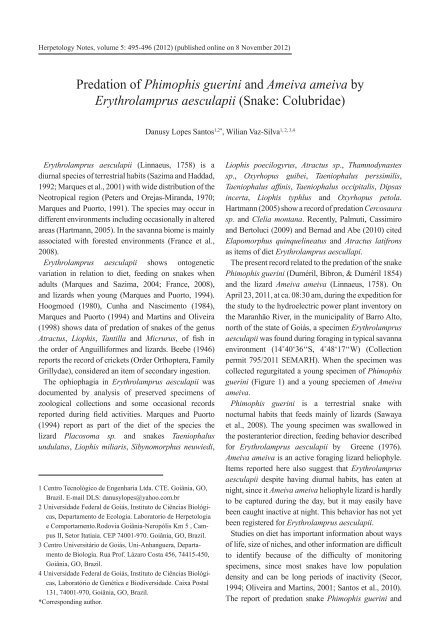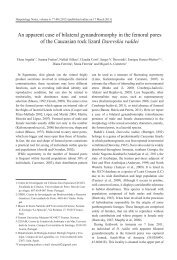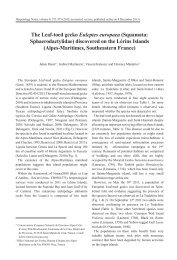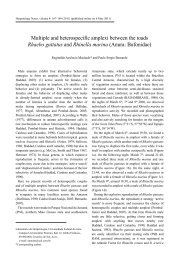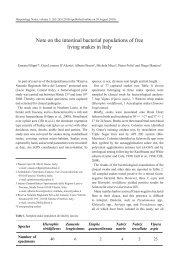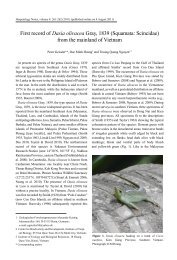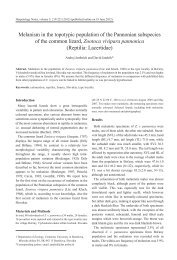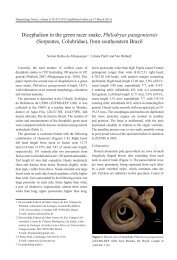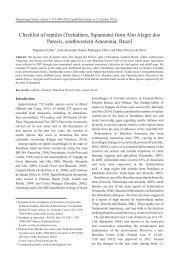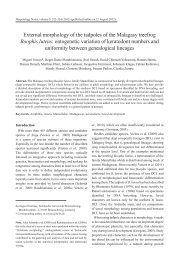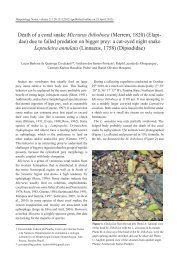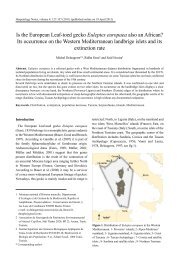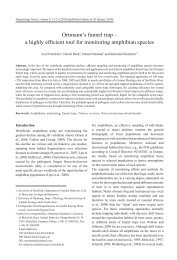Erythrolamprus aesculapii - Herpetology Notes
Erythrolamprus aesculapii - Herpetology Notes
Erythrolamprus aesculapii - Herpetology Notes
You also want an ePaper? Increase the reach of your titles
YUMPU automatically turns print PDFs into web optimized ePapers that Google loves.
<strong>Herpetology</strong> <strong>Notes</strong>, volume 5: 495-496 (2012) (published online on 8 November 2012)<br />
Predation of Phimophis guerini and Ameiva ameiva by<br />
<strong>Erythrolamprus</strong> <strong>aesculapii</strong> (Snake: Colubridae)<br />
<strong>Erythrolamprus</strong> <strong>aesculapii</strong> (Linnaeus, 1758) is a<br />
diurnal species of terrestrial habits (Sazima and Haddad,<br />
1992; Marques et al., 2001) with wide distribution of the<br />
Neotropical region (Peters and Orejas-Miranda, 1970;<br />
Marques and Puorto, 1991). The species may occur in<br />
different environments including occasionally in altered<br />
areas (Hartmann, 2005). In the savanna biome is mainly<br />
associated with forested environments (France et al.,<br />
2008).<br />
<strong>Erythrolamprus</strong> <strong>aesculapii</strong> shows ontogenetic<br />
variation in relation to diet, feeding on snakes when<br />
adults (Marques and Sazima, 2004; France, 2008),<br />
and lizards when young (Marques and Puorto, 1994).<br />
Hoogmoed (1980), Cunha and Nascimento (1984),<br />
Marques and Puorto (1994) and Martins and Oliveira<br />
(1998) shows data of predation of snakes of the genus<br />
Atractus, Liophis, Tantilla and Micrurus, of fish in<br />
the order of Anguilliformes and lizards. Beebe (1946)<br />
reports the record of crickets (Order Orthoptera, Family<br />
Grillydae), considered an item of secondary ingestion.<br />
The ophiophagia in <strong>Erythrolamprus</strong> <strong>aesculapii</strong> was<br />
documented by analysis of preserved specimens of<br />
zoological collections and some occasional records<br />
reported during field activities. Marques and Puorto<br />
(1994) report as part of the diet of the species the<br />
lizard Placosoma sp. and snakes Taeniophalus<br />
undulatus, Liophis miliaris, Sibynomorphus neuwiedi,<br />
1 Centro Tecnológico de Engenharia Ltda. CTE. Goiânia, GO,<br />
Brazil. E-mail DLS: danusylopes@yahoo.com.br<br />
2 Universidade Federal de Goiás, Instituto de Ciências Biológicas,<br />
Departamento de Ecologia. Laboratorio de Herpetologia<br />
e Comportamento.Rodovia Goiânia-Neropólis Km 5 , Campus<br />
II, Setor Itatiaia. CEP 74001-970. Goiânia, GO, Brazil.<br />
3 Centro Universitário de Goiás, Uni-Anhanguera, Departamento<br />
de Biologia. Rua Prof. Lázaro Costa 456, 74415-450,<br />
Goiânia, GO, Brazil.<br />
4 Universidade Federal de Goiás, Instituto de Ciências Biológicas,<br />
Laboratório de Genética e Biodiversidade. Caixa Postal<br />
131, 74001-970, Goiânia, GO, Brazil.<br />
*Corresponding author.<br />
Danusy Lopes Santos1,2* 1, 2, 3,4<br />
, Wilian Vaz-Silva<br />
Liophis poecilogyrus, Atractus sp., Thamnodynastes<br />
sp., Oxyrhopus guibei, Taeniophalus perssimilis,<br />
Taeniophalus affinis, Taeniophalus occipitalis, Dipsas<br />
incerta, Liophis typhlus and Oxyrhopus petola.<br />
Hartmann (2005) show a record of predation Cercosaura<br />
sp. and Clelia montana. Recently, Palmuti, Cassimiro<br />
and Bertoluci (2009) and Bernad and Abe (2010) cited<br />
Elapomorphus quinquelineatus and Atractus latifrons<br />
as items of diet <strong>Erythrolamprus</strong> aescullapi.<br />
The present record related to the predation of the snake<br />
Phimophis guerini (Duméril, Bibron, & Duméril 1854)<br />
and the lizard Ameiva ameiva (Linnaeus, 1758). On<br />
April 23, 2011, at ca. 08:30 am, during the expedition for<br />
the study to the hydroelectric power plant inventory on<br />
the Maranhão River, in the municipality of Barro Alto,<br />
north of the state of Goiás, a specimen <strong>Erythrolamprus</strong><br />
<strong>aesculapii</strong> was found during foraging in typical savanna<br />
environment (14˚40‘36‘‘S, 4˚48‘17‘‘W) (Collection<br />
permit 795/2011 SEMARH). When the specimen was<br />
collected regurgitated a young specimen of Phimophis<br />
guerini (Figure 1) and a young speciemen of Ameiva<br />
ameiva.<br />
Phimophis guerini is a terrestrial snake with<br />
nocturnal habits that feeds mainly of lizards (Sawaya<br />
et al., 2008). The young specimen was swallowed in<br />
the posteranterior direction, feeding behavior described<br />
for <strong>Erythrolamprus</strong> <strong>aesculapii</strong> by Greene (1976).<br />
Ameiva ameiva is an active foraging lizard heliophyle.<br />
Items reported here also suggest that <strong>Erythrolamprus</strong><br />
<strong>aesculapii</strong> despite having diurnal habits, has eaten at<br />
night, since it Ameiva ameiva heliophyle lizard is hardly<br />
to be captured during the day, but it may easily have<br />
been caught inactive at night. This behavior has not yet<br />
been registered for <strong>Erythrolamprus</strong> <strong>aesculapii</strong>.<br />
Studies on diet has important information about ways<br />
of life, size of niches, and other information are difficult<br />
to identify because of the difficulty of monitoring<br />
specimens, since most snakes have low population<br />
density and can be long periods of inactivity (Secor,<br />
1994; Oliveira and Martins, 2001; Santos et al., 2010).<br />
The report of predation snake Phimophis guerini and
496<br />
Figure 1. <strong>Erythrolamprus</strong> <strong>aesculapii</strong> starting the process of<br />
regurgitation of the young specimen of Phimophis guerini.<br />
lizard Ameiva ameiva adds two items not yet reported in<br />
the literature to the diet of <strong>Erythrolamprus</strong> <strong>aesculapii</strong>,<br />
also shows unprecedented behavior in their eating<br />
habits.<br />
Acknowledgements. We thank Rafael Balestrin for reading<br />
the manuscript and valuable suggestions, Paola da Mata for the<br />
help in collecting the specimen. The Fabricio H. Oda, Andrei G.<br />
Guedes, and Sheila P. Andrade for comments and suggestions..<br />
Delana Lopes for the help with english. CTE Engenharia is the<br />
enterprise responsible by the execution of Faunal Inventory of<br />
UHE Laguna.<br />
References<br />
Beebe, W. (1946): Field notes on the snakes of Kartabo, British<br />
Guiana, and Caripito, Venezuela. Zoologica 31: 11-52.<br />
Cunha, O.R., Nascimento, F.P. (1984): Ofidios da Amazonia XXI<br />
- Atractus zidoki no leste do Para e notas sobre A. alphonsehogei<br />
e A. schach (Ophidia, Colubridae). Boletim do Museu Paraense<br />
Emílio Goeldi. Série Zoologia, Belém 1(2): 219-228.<br />
Hartmann, P.A. (2005): História natural e ecologia de duas taxocenoses<br />
de serpentes na Mata Atlântica. Tese de Doutorado,<br />
Universidade Estadual Paulista “Júlio de Mesquita Filho”, Rio<br />
Claro. 116p.<br />
Hoogmoed, M.S. (1980): Revision of the genus Atractus in Surinam,<br />
with the resurrection of two species (Colubridae, Reptilia).<br />
<strong>Notes</strong> on the herpetofauna of Surinam VII. Zoologische<br />
Verhandelingen 175: 1-47.<br />
Danusy Lopes Santos & Wilian Vaz-Silva<br />
Marques, O.A.V., Puorto, G. (1991): Padrões cromáticos, distribuição<br />
e possível mimetismo em <strong>Erythrolamprus</strong> <strong>aesculapii</strong><br />
(Serpentes, Colubridae). Memórias do Instituto Butantan<br />
53(1): 127-134.<br />
Marques, O.A.V., Puorto, G. (1994): Dieta e comportamento alimentar<br />
de <strong>Erythrolamprus</strong> <strong>aesculapii</strong>. Revista Brasileira de<br />
Biologia 54(2): 253-259.<br />
Marques, O.A.V., Sazima, I. (2004): História natural dos répteis<br />
da Estação Ecológica Juréia-Itatins. In: Estação Ecológica Juréia-Itatins.<br />
Ambientes físico, flora e fauna, p. 257-277. Marques,<br />
O.A.V., Dulepa, W., Eds., Ribeirão Preto, Holos.<br />
Marques, O.A.V., Eterovick, A, Sazima, I. (2001): Serpentes da<br />
Mata Atlântica: Guia Ilustrado para Serra do Mar. Ribeirão<br />
Preto, Holos.<br />
Martins, M., Oliveira, M.E. (1998): Natural history of snakes in<br />
forests of the Manaus region, Central Amazonia, Brazil. Herpetological<br />
Natural History 6: 78-150.<br />
Oliveira, M.E., Martins, M. (2001): When and where to find a pitviper:<br />
activity patterns and habitat use of a lancehead Bothrops<br />
atrox, in central Amazonia, Brazil. Herpetological Natural History<br />
8(2): 101-110.<br />
Palmuti, C.F.S., Cassimiro, J., Bertoluci, J. (2009): Hábito alimentar<br />
de serpentes da RPPN Feliciano Miguel Abdala, um<br />
fragmento de Mata Atlântica do sudeste do Brasil. Biota Neotropica<br />
9(1): 264-268<br />
Peters, J.A., Orejas-Miranda, B. (1970): Catalogue of the Neotropical<br />
Squamata. Part I. Snakes. Bulletin United States National<br />
Museum 297: 1-347.<br />
Santos, M.B., Huckembeck, S., Bergmann, F.B., Tozetti, A.M.<br />
(2010): Comportamento alimentar aquático de Liophis jaegeri<br />
(Günther 1858) (Serpentes, Dipsadidae) em cativeiro. Biota<br />
Neotropica 10(4): 343-346.<br />
Sazima, I., Haddad, C.F.B. (1992): Répteis da Serra do Japi: notas<br />
sobre história natural. In: História natural da Serra do Japi:<br />
ecologia e preservação de uma área florestal no Sudeste do<br />
Brasil, p. 212-236. Morellato, L.P.C., Ed., Campinas, Editora<br />
da Unicamp/FAPESP.<br />
Sawaya, R.J., Marques, O.A.V., Martins, M. (2008): Composição<br />
e história natural das serpentes de Cerrado de Itirapina, São<br />
Paulo, Sudeste do Brasil. Biota Neotropica 8(2): 127-149.<br />
Secor, S.M. (1994): Ecological significance of movements and<br />
activity range for the side winder, Crotalus cerastes. Copeia<br />
1994(3): 631-645.<br />
Accepted by Phillip de Pous


